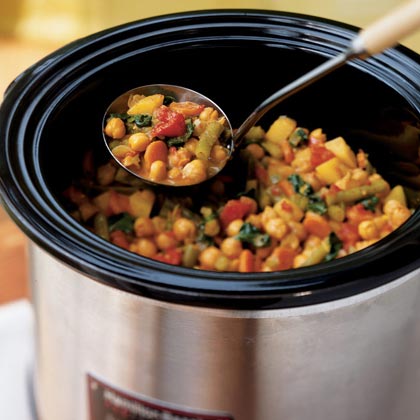Slow cookers can be used to prepare just about any meal imaginable. And it’s simple. Prep the ingredients, add them to a slow cooker and press start.
But wait. There is a difference between a good slow-cooker meal and a great slow-cooker meal. Here are some tips to keep in mind when using a slow cooker.
- Don’t overfill the cooker. Generally, a slow cooker should never be filled more than 2/3 full. Otherwise, foods don’t cook properly.
- Use the LOW (approximately 180 degrees) temperature for most meats. At higher temperatures, meat proteins begin to tighten and toughen. Given the opportunity, use LOW to cook most dishes as they tend to turn out more moist and tender than when cooked on HIGH.
- For even cooking, cut food into uniform-size pieces. Place firm, slow-cooking root vegetables like potatoes and carrots at the bottom and place the meat on top
- Don’t try to cook on the KEEP WARM (approximately 140 degrees). This is just too low for food safety. A good rule of thumb is using this setting for up to four hours only for keeping foods warm.
- For high-altitude cooking, add an additional 30 minutes for each hour of time specified in the recipe. Know that legumes will take about twice as long to cook as they will at sea level.
- Always completely defrost meats and larger vegetable quantities before adding to the slow cooker. Adding frozen cuts of meats presents a food safety issue. In addition, frozen products will increase the cooking time considerably.
- Although it’s not necessary, browning meats (and some vegetables) before placing them in a slow cooker, intensifies their flavor. With meat, especially, the caramelization that occurs with browning heightens the flavor. Sautéing onion and garlic before adding to a slow cooker dish mellows their flavor enhancing sweetness.
- Add tender vegetables, grains and herbs during the last 30 minutes or so to your dish so they don’t disintegrate. While carrots and corn will remain intact for a long stewing period, lentils will fall apart.
- Slow cooking tends to diminish the flavor of aromatics, so include more than you might use when cooking on the stovetop or in the oven. Add a flavor boost toward the end of the cooking time by tossing in some fresh herbs or a splash of lemon juice.
- For dishes with a tendency to stick, use foil to line the slow cooker insert and turn the insert around about half way through the cooking time. The heating element is usually on the opposite side from the control.
- Keep the cover on as much as possible but do stir occasionally. Just be sure to return the cover as quickly as possible so as not to extend the cooking time too much.
- Use your slow cooker year-round and use it often. During summer, a slow cooker won’t heat up your kitchen like an oven will, and it provides added time to enjoy outside activities.
- Don’t confine yourself to one-pot meals. Bake a cake or a cobbler or some overnight Irish oatmeal or some rich, nut-topped French toast for breakfast or brunch. Holiday meals got you stressed? Cook that turkey breast, cranberry sauce, mashed potatoes or cornbread dressing in a slow cooker to save space on the counter or in the oven.
- Foods prepared in a slow cooker need to be eaten, cooled and stored just as they do with other cooking methods. Don’t use the slow cooker to reheat foods either as it heats too slowly for food safety.
Need any advice or a question answered about slow cooking? Leave a comment on this post, and we’ll be happy to try and help.
What are some of your slow cooker favorite dishes and tips? I hope you’ll share.
 Arkansas Women Blogger member and co-administrator Debbie Arnold pontificates and eats at Dining With Debbie. She and her Hubby split their time between Central and Northwest Arkansas. She loves to cook, develop recipes and have play dates with her two perfect grands. Mostly, she has play dates with the Perfect Ones
Arkansas Women Blogger member and co-administrator Debbie Arnold pontificates and eats at Dining With Debbie. She and her Hubby split their time between Central and Northwest Arkansas. She loves to cook, develop recipes and have play dates with her two perfect grands. Mostly, she has play dates with the Perfect Ones
